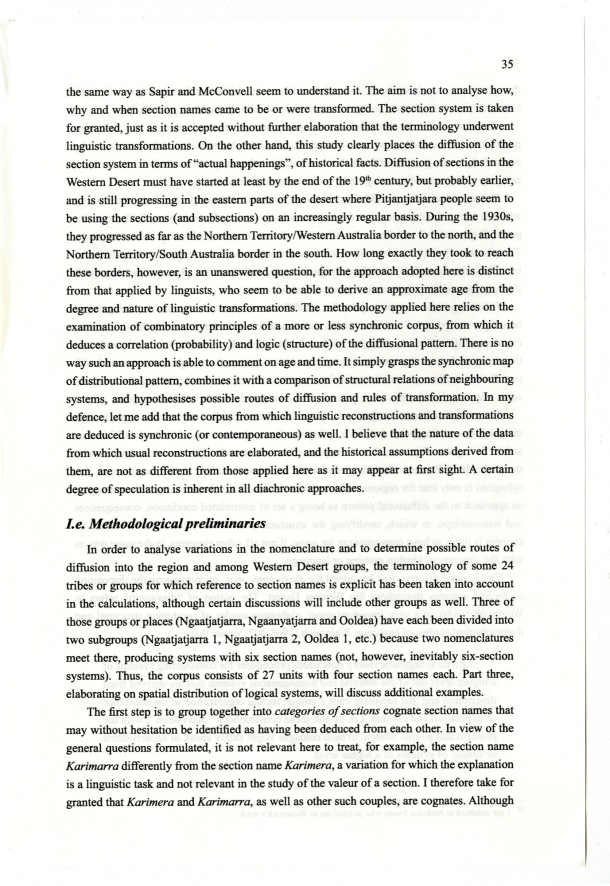|
| 
[Note: this transcription was produced by an automatic OCR engine]
35
the same way as Sapir and McConvell seem to understand it. The aim is not to analyse how,
why and when section names came to be or were transformed. The section system is taken
for granted, just as it is accepted without fiirther elaboration that the terminology underwent
linguistic transformations. On the other hand, this study clearly places the diffusion of the
section system in terms of “actual happenings”, of historical facts. Difliision of sections in the
Western Desert must have started at least by the end of the 19“‘ century, but probably earlier,
and is still progressing in the eastern parts of the desert where Pitjantjatjara people seem to
be using the sections and subsections on an increasingly regular basis. During the 1930s,
they progressed as far as the Northern Territory/Western Australia border to the north, and the
Northern Territory/South Australia border in the south. How long exactly they took to reach
these borders, however, is an rmanswered question, for the approach adopted here is distinct
fiom that applied by linguists, who seem to be able to derive an approximate age from the
degree and nature of linguistic transformations. The methodology applied here relies on the
examination of combinatory principles of a more or less synchronic corpus, from which it
deduces a correlation probability and logic structure of the difliisional pattern. There is no
way such an approach is able to comment on age and time. It simply grasps the synchronic map
of distributional pattern, combines it with a comparison of structural relations of neighbouring
systems, and hypothesises possible routes of difiusion and rules of transformation. In my
defence, let me add that the corpus from which linguistic reconstructions and transformations
are deduced is synchronic or contemporaneous as well. I believe that the nature of the data
from which usual reconstructions are elaborated, and the historical assumptions derived from
them, are not as difierent from those applied here as it may appear at first sight. A certain
degree of speculation is inherent in all diachronic approaches.
I.e. Methodological preliminaries
In order to analyse variations in the nomenclature and to determine possible routes of
diffusion into the region and among Western Desert groups, the terminology of some 24
tribes or groups for which reference to section names is explicit has been taken into account
in the calculations, although certain discussions will include other groups as well. Three of
those groups or places Ngaatjatjarra, Ngaanyatjarra and Ooldea have each been divided into
two subgroups Ngaatjatjarra 1, Ngaatjatjarra 2, Ooldea 1, etc. because two nomenclatures
meet there, producing systems with six section names not, however, inevitably six-section
systems. Thus, the corpus consists of 27 units with four section names each. Part three,
elaborating on spatial distribution of logical systems, will discuss additional examples.
The first step is to group together into categories of sections cognate section names that
may without hesitation be identified as having been deduced from each other. In view of the
general questions fomrulated, it is not relevant here to treat, for example, the section name
Karimarm difl°erently from the section name Karimera, a variation for which the explanation
is a linguistic task and not relevant in the study of the valeur of a section. I therefore take for
granted that Karimera and Karimarra, as well as other such couples, are cognates. Although
|